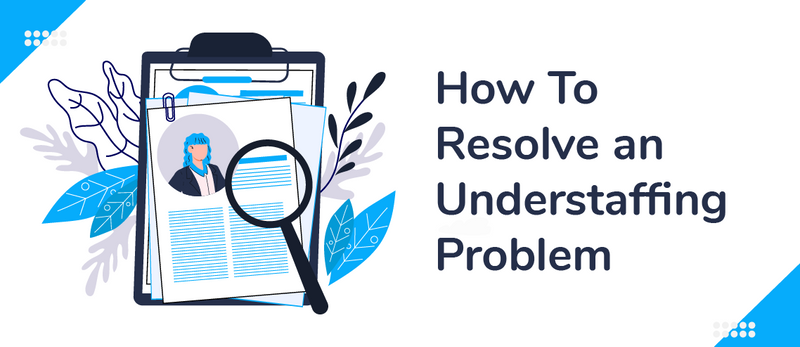How to Resolve an Understaffing Problem in The Workplace

As COVID and the socio-political environment continue to throw the world into flux, many businesses are finding themselves understaffed. This period of time has been termed the “Great Resignation” as many workers are finding that businesses aren’t offering working conditions they are willing to accept. This is leaving businesses without enough employees to stay open.
There’s no doubt that this is a major problem for businesses, employees, and consumers alike. If your business hasn’t had to face the troubles that come from understaffing yet, then it’s best to prepare now so that you can be ready if it becomes an issue for you and your livelihood.
What Is Understaffing?
Understaffing refers to a situation in which a business does not employ enough workers. When a business is understaffed, it means that there aren’t enough employees to cover all the shifts, production is too slow, or another personnel problem that hurts the business in a similar way.
Sometimes people will refer to a temporary staff shortage as being understaffed. For example, if you employ enough workers, but all of your employees call out sick on the same day, then that may be referred to as temporary understaffing. However, the causes of each of these problems are different, so it’s important to be able to distinguish between when understaffing is a long-term or short-term issue.
What’s The Problem With Understaffing
For the most part, the problems with understaffing are fairly obvious: if you have four shifts that need to be staffed, and each shift requires one worker, but you only have two workers, then you won’t be able to stay open for all of those shifts. That means that you’ll be losing out on potential profits.
But there are multiple other effects of being short-staffed as well that can be harder to see. In reality, when a business is understaffed, it doesn’t necessarily mean that it won’t fulfill all of the necessary functions or reduce its hours. Instead, the business might overwork the employees they do have to make up for that gap.
And that’s a problem. When employees are overworked, they can start to burn out. To some, that may sound like it’s not that big of a problem, but burnout is actually an internationally recognized health condition with its own ICD-11 code.
When employees are overworked, it means that they have too much on their plate. They aren’t able to dedicate the requisite amount of time and attention to perform each of their tasks.
That can lead to missed deadlines, decreased customer satisfaction, and even injuries, illness, or even death. If an employee is working back-to-back 16-hour days and fulfilling the duties of several employees, the risk of a mistake or accident greatly increases. To overcome all these problems — you need to constantly encourage employees when short staffed issue has arisen.
If you’ve already got an understaffing issue on your hands, here are some tips you can use to start taking care of it.
Six Tips to Resolve Understaffing Problems
1. Assess Your Staffing Needs
Before you do anything else, your first course of action should be to conduct a careful analysis of what your current staffing needs are. Without understanding how many employees you actually need, it will be impossible to come up with an actionable plan to resolve the understaffing problems.
To do this, you can start by making a list of all the shifts and tasks you need to be covered. Then, see how much your current employees can take care of. From there, you can start to get an idea of how much each employee can handle and how many additional employees you’ll need.
A note of caution: make sure that you get your employees’ input as to how much work they can reasonably handle. Employers don’t always have an accurate view of how much goes into each task, so it’s important to consult the people who are actually doing those jobs.
2. Implement Technology
There are lots of tools available that can help with every aspect of running a business, from hiring new employees to scheduling your current ones to managing payroll. If you need to hire more employees, it may be worth looking into recruiting software, like Recruiterflow, BambooHR or JazzHR.
To prevent temporary understaffing problems, you can also start using employee scheduling tools, like ZoomShift. It will help you keep a more organized schedule and get better visibility on who is working when and where, and when your employees are taking time off. Adding in communication tools like Slack, Skype or Google Hangout can also help your team coordinate with each other better, which can help prevent temporary understaffing as well.
3. Add Temporary Staff
Ultimately, if you’re faced with a staffing shortage problem, the only real solution is to hire more staff members. However, you don’t necessarily need to hire full-time employees who will be on your team indefinitely.
If you believe that your staffing shortage will resolve in a relatively short amount of time, then temporary staffing may be the way to go. This can be especially useful for businesses that need more staff during particularly busy periods of the year, like the holidays. Instead of hiring more year-round employees who won’t have enough work throughout most of the year, you can just hire temporary staff for that season.
4. Outsource Tedious Tasks
If your current employees are being bogged down by clerical and tedious tasks, like data entry, it can be useful to outsource those. One effect of the ongoing economic changes is that there has been a big boom in the freelance market.
So it’s a viable option to find freelancers who can take care of some tasks. It will leave your employees with more time and energy to dedicate to their primary duties.
5. Work With a Staffing Agency
No matter whether you’re looking for temporary workers, contract workers, or long-term full-time employees, a staffing agency can help you find the right fit for your needs. Staffing agencies are dedicated to helping businesses adequately staff themselves, so if you’re facing an understaffing problem, this should be high up on your list of next steps.
6. Consider Internships
If you’re understaffed at work, you may want to consider adding some paid interns to your staff. This can be a great way for those who are starting out in their careers to get some much-needed experience without much commitment from either side.
Keep in mind that as a result of the labor shortage, unpaid internships will likely not be very appealing even to those with little to no experience. Overall, unpaid internships are going out of style and are starting to be viewed in a negative light, but that holds especially true when many small businesses are offering unusually high wages to inexperienced workers due to shortages.
How ZoomShift Can Help Prevent Understaffing
ZoomShift is a scheduling tool that is designed to make employee scheduling easier. It provides an easy-to-use drag-and-drop visual scheduling interface that employers can use to more easily see what shifts are being filled, when employees are taking off, and to update their employees about changes in the schedule.
While ZoomShift can’t magically get you more employees if you’re already understaffed, it can help you get better visibility into what your schedule looks like moving forward so that you can nip understaffing issues in the bud. Thanks to its clean and intuitive scheduling interface, understaffing issues can be caught more easily than with other scheduling methods.
ZoomShift also helps prevent human error when it comes to scheduling, which can reduce the incidence of temporary understaffing. In the past, when an employee wanted time off or couldn’t come in for a shift, they would tell their manager, and the manager would then have to remember to update the team and make accommodations. However, this system is prone to error—the manager could be busy at the moment and forget to take care of it or there could be a miscommunication between the two of them.
With ZoomShift, employees can request shift swaps and time off within the app, and the schedule will only update when the changes are final. That way, everything is taken care of in a streamlined and semi-automated manner, and there is less risk of confusion or miscommunication.
Key Takeaways
Understaffing is an issue that is currently plaguing many businesses as a result of the current pandemic and social, political, and economic climate. Luckily, there are many avenues that small businesses can pursue to prevent and resolve this issue, ranging from using tools like ZoomShift to hiring a staffing agency to help find more employees. Above all don’t forget to encourage employees when short staffed — they are the ones who will take care of your business.
JD enjoys teaching people how to use ZoomShift to save time spent on scheduling. He’s curious, likes learning new things everyday and playing the guitar (although it’s a work in progress).



